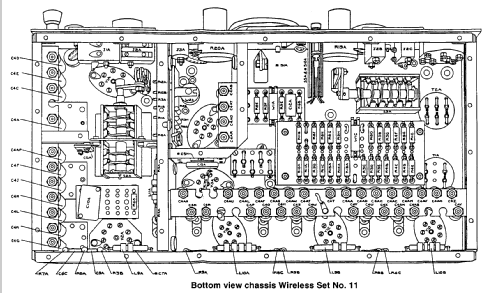Wireless Set No.11
MILITARY U.K. (different makers for same model)
- Country
- Great Britain (UK)
- Manufacturer / Brand
- MILITARY U.K. (different makers for same model)
- Year
- 1938–1942
- Category
- Military Transceiver (TRX)
- Radiomuseum.org ID
- 203445
Click on the schematic thumbnail to request the schematic as a free document.
- Number of Tubes
- 8
- Main principle
- Transceiver; ZF/IF 475 kHz
- Wave bands
- Short Wave (SW only)
- Power type and voltage
- Storage and/or dry batteries / 6 & 240 Volt
- Loudspeaker
- - For headphones or amp.
- Material
- Metal case
- from Radiomuseum.org
- Model: Wireless Set No.11 - MILITARY U.K. different makers
- Shape
- Boatanchor (heavy military or commercial set >20 kg).
- Dimensions (WHD)
- 19.5 x 8.5 x 12 inch / 495 x 216 x 305 mm
- Notes
- Wireless set No. 11: Short range transceiver covering 4,2 - 7,5 MHz, AM (A3) and CW (A1), pout on Low power 0,6 Watt telephony, 1,5 Watt CW, on High power 1,5 Watt telephony and 4,5 Watt CW;
powered for Low power operation bei 6V LT accumulator and 240V dry battery or 6V LT accumulator and 6 V Low power supply with rotary converter for HT 230V, for High power operation a 12V or two 6 V HT accumulators, a 12V Low power unit and an additional 12V High power unit with rotary converter for the additional HT of 480V; six foot vehicle or 9 foot ground antenna;
used by British Army for short range communications on armoured fighting vehicles or on trucks, as animal pack station (on mules) or as ground station.
The Wireless Set No. 11 as a successor to the Wireless Set No.1 which was too complex for mass production, was developed in 1936 in collaboration of the SEE and E.K.Cole, a first batch of 20 sets were produced for trials in 1937.
Production models were delivered from 1938, production numbers reached around 19000 sets in 1942; the Wireless Set No.11 was the backbone of short range communications of the British Army in early WW II together with the Wireless Set No.9. A large number of Wireless Sets No.11 have been captured by German troops when the British Expeditionary Corps had to retreat back from France in 1940.
The successor of the sets were the Wireless Set. No.19 for use onboard tanks and the Wireless Set. No.21 as ground station and for non-AFV use.
- Mentioned in
- Wireless for the Warrior Vol. 1, L. Meulstee
- Author
- Model page created by Martin Bösch. See "Data change" for further contributors.
- Other Models
-
Here you find 146 models, 114 with images and 48 with schematics for wireless sets etc. In French: TSF for Télégraphie sans fil.
All listed radios etc. from MILITARY U.K. (different makers for same model)




